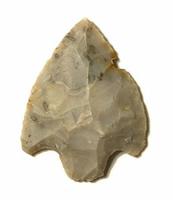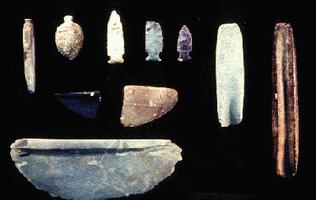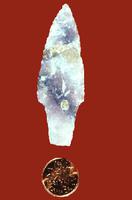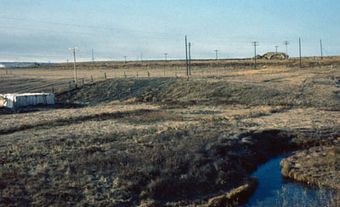Archaic
The Archaic culture comprises several cultural manifestations spanning nearly seven thousand years, from 10 000 years to 3000 years Before Present (BP). This period is generally divided into three distinct cultural episodes: Early Archaic (10 000 to 8000 BP), Middle Archaic (8000 to 6000 BP) and Late Archaic (6000 to 3000 BP).
Experts classify the Archaic cultures under different names, based on regions and cultural traits: Maritime culture in the Maritimes and on the coast of Labrador (see Labrador Archaic); Laurentian culture in the St Lawrence Valley and southern Ontario; Shield culture in northwestern Quebec, northern Ontario and Manitoba; Plains culture in Saskatchewan and Alberta; and Plateau culture on the west coast and the Northwest interior of Canada's west coast.
Early and Middle Archaic
In Canada, there are very few remains of the Early and Middle Archaic cultures (10 000 to 6000 years BP), due in part to the extreme weather conditions that existed at that time. It is also possible that areas with high potential for remains are now submerged under the Great Lakes or the Atlantic or stand on high wooded terraces and are therefore inaccessible, due to the high fluctuations in water levels that occurred at this period. Finally, the persistence of the Palaeoindian culture in some regions and the overlap between the Palaeoindian and Archaic cultures in other areas complicate the archaeological record.
Most archaeological sites dating from the Early and Middle Archaic period have been found on the north coast of the Gulf of St Lawrence in Québec and Labrador, where the elevation of the coastline has contributed to site preservation. Besides the evolution and diversification of the lithic (stone) technology over time and by region, the transition from the Palaeoindian period to the Archaic period was marked by a greater use of locally harvested stone or stone from closer sources, and by the advent of technological innovations including the polished stone adze.
Late Archaic
Over time, environmental conditions became less restrictive. Around 6000 BP, the river systems stabilized and gradually reached their current position. The cold, austere habitat created by the removal of the continental ice gave way to a more inviting landscape that was probably closely similar to that encountered by the early European explorers upon their arrival in Canada. A diverse vegetation gradually evolved and rapidly colonized the freshly emerged lands, covering them with boreal forest or Arctic tundra depending on the latitude. During this period, Late Archaic groups (6000 to 3000 BP) permanently settled in Canada and cultural regionalization increased. As during the Palaeoindian period, Late Archaic peoples had a nomadic way of life involving seasonal movements depending on the availability of food resources. However, it appears that their food-acquisition methods allowed them to reduce their movements and exploit more restricted territories.
The subsistence strategies varied considerably at that time according to the availability of regional resources. Whereas the Maritime culture adopted a diet based primarily on marine resources (seals, walrus, swordfish, etc.), the Laurentian and Shield cultures relied on fishing and hunting caribou and deer. The Plains culture intensively hunted bison and the Plateau culture fished for salmon and hunted for deer, whereas groups living on Canada's west coast incorporated shellfish (see Shell Middens) in their diet.
Camps were generally located along river banks and were mostly limited in size, although much larger camps could be found along major rivers, in the interior or on the coast. Houses at this time differed significantly between regions. For instance, the remains of small rectangular or circular huts were found in Laurentian territory, while the Plateau culture built impressive semi-subterranean structures, sometimes grouped in small villages.
During this period, stone tools became more complex and included polished tools in addition to chipped tools. The use of bone as a raw material for manufacturing needles, fish hooks, harpoons and perforators became more widespread. The thin and usually symmetrical projectile points characteristic of the Palaeoindian culture were gradually replaced by irregular and thicker notched or stemmed points, or by lanceolate (lance-shaped) points.
Depending on the area, chipped stone tools (projectile points, microblades, bifaces, scrapers, etc.) were produced from various materials, mainly chert, jasper, quartzite, chalcedony and rhyolite, sometimes from local sources. Polished stone tools included gouges, axes, adzes, slate points, etc. There were even artifacts (projectile points, axes, hooks, harpoons and various perforators) made of native copper from Lake Superior in Eastern Canada, and remains of red cedar bark basketry were found in Western Canada.
Towards the end of the Archaic period, the gradual transition from a nomadic way of life to an embryonic form of semi-sedentary lifestyle and the adoption of domestic ceramic pottery marked the imminent development of another period the experts refer to as the woodland culture, which was characterized by a series of significant cultural changes.
See also Prehistory; Archaeology.

 Share on Facebook
Share on Facebook Share on X
Share on X Share by Email
Share by Email Share on Google Classroom
Share on Google Classroom






